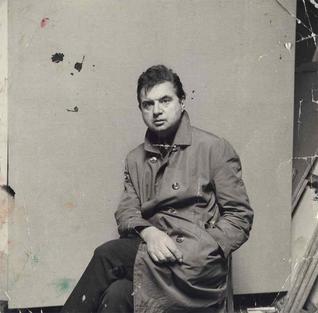
Francis Bacon was an Irish-born British figurative painter known for his raw, unsettling imagery. Focusing on the human form, his subjects included crucifixions, portraits of popes, self-portraits, and portraits of close friends, with abstracted figures sometimes isolated in geometrical structures. Rejecting various classifications of his work, Bacon said he strove to render "the brutality of fact." He built up a reputation as one of the giants of contemporary art with his unique style.

Lucian Michael Freud was a British painter and draughtsman, specialising in figurative art, and is known as one of the foremost 20th-century English portraitists. He was born in Berlin, the son of Jewish architect Ernst L. Freud and the grandson of Sigmund Freud. Freud got his first name "Lucian" from his mother in memory of the ancient writer Lucian of Samosata. His family moved to England in 1933, when he was 10 years old, to escape the rise of Nazism. He became a British naturalized citizen in 1939. From 1942 to 1943 he attended Goldsmiths College, London. He served at sea with the British Merchant Navy during the Second World War.
Graham Vivian Sutherland was a prolific English artist. Notable for his paintings of abstract landscapes and for his portraits of public figures, Sutherland also worked in other media, including printmaking, tapestry and glass design.
Events from the year 1952 in art.
George Peter Lanyon was a British painter of landscapes leaning heavily towards abstraction. Lanyon was one of the most important artists to emerge in post-war Britain. Despite his early death at the age of forty-six he achieved a body of work that is amongst the most original and important reappraisals of modernism in painting to be found anywhere. Combining abstract values with radical ideas about landscape and the figure, Lanyon navigated a course from Constructivism through Abstract Expressionism to a style close to Pop. He also made constructions, pottery and collage.
Nicolas de Staël was a French painter of Russian origin known for his use of a thick impasto and his highly abstract landscape painting. He also worked with collage, illustration and textiles.

Three Studies for Figures at the Base of a Crucifixion is a 1944 triptych painted by the Irish-born British artist Francis Bacon. The canvasses are based on the Eumenides—or Furies—of Aeschylus's Oresteia, and depict three writhing anthropomorphic creatures set against a flat burnt orange background. It was executed in oil paint and pastel on Sundeala fibre board and completed within two weeks. The triptych summarises themes explored in Bacon's previous work, including his examination of Picasso's biomorphs and his interpretations of the Crucifixion and the Greek Furies. Bacon did not realise his original intention to paint a large crucifixion scene and place the figures at the foot of the cross.
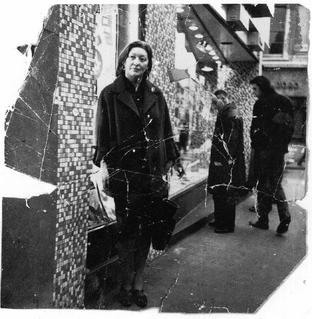
Isabel Rawsthorne, also known at various times as Isabel Delmer and Isabel Lambert, was a British painter, scenery and costume designer, and occasional artists' model. During the Second World War she worked in black propaganda. She was part of an artistic bohemian society that included Jacob Epstein, Alberto Giacometti and Francis Bacon.
Peter Prendergast was a Welsh landscape painter. After the death of Sir Kyffin Williams in September 2006, he was recognised/known as the leading landscape painter in Wales.

Second Version of Triptych 1944 is a 1988 triptych painted by the Irish-born artist Francis Bacon. It is a reworking of Three Studies for Figures at the Base of a Crucifixion, 1944, Bacon's most widely known triptych, and the one which established his reputation as one of England's foremost post-war painters.
Martin Harrison is a British art historian, author and curator, noted for his work on photography, on the medium of stained glass and its history, and as an authority on the work of the painter Francis Bacon.
Edgar Hubert (1906-1985) was a British abstract painter.
Frances Macdonald, was an English painter known for her panoramic scenes painted in Wales, the south of France and in London during World War II.

Three Studies of the Male Back is a 1970 oil-on-canvas triptych by the British painter Francis Bacon. Typical of Bacon's figurative but abstract and distorted style, it depicts male figures isolated within flat nondescript interior spaces. Each figure is a portrait of Bacon's lover George Dyer.
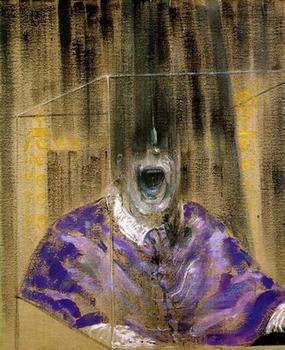
Head VI is an oil-on-canvas painting by Irish-born figurative artist Francis Bacon, the last of six panels making up his "1949 Head" series. It shows a bust view of a single figure, modeled on Diego Velázquez's Portrait of Innocent X. Bacon applies forceful, expressive brush strokes, and places the figure within a glass cage structure, behind curtain-like drapery. This gives the effect of a man trapped and suffocated by his surroundings, screaming into an airless void. But with an inverted pathos is derived from the ambiguity of the pope's horrifying expression—whose distorted face either screams of untethered hatred towards the viewer or pleads for help from the glass cage—the question of what he is screaming about is left to the audience.
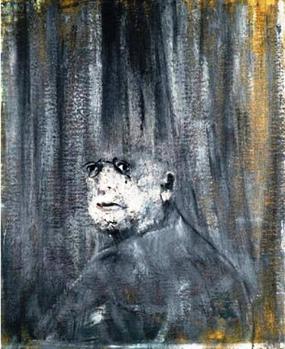
Head III is an oil painting by Francis Bacon, one of series of works made in 1949 for his first one-man exhibition at the Hanover Gallery, in London. As with the other six paintings in the series, it focuses on the disembodied head of male figure, who looks out with a penetrating gaze, but is fixed against an isolating, flat, nondescript background, while also enfolded by hazy horizontal foreground curtain-like folds which seems to function like a surrounding cage.

Head V is a 1949 painting by Irish-born British artist Francis Bacon, one of series of works made in 1949 for his first one-man exhibition at the Hanover Gallery, in London. It measures 82 by 66 centimetres and is held in a private collection.
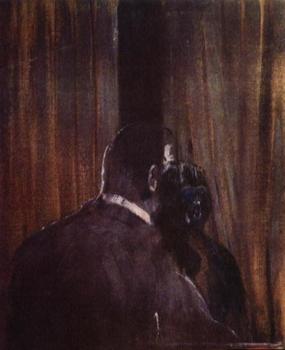
Head IV, sometimes subtitled Man with a Monkey, is a 1949 painting by Irish-born British artist Francis Bacon, one of series of works made in 1949 for his first one-man exhibition at the Hanover Gallery, in London. It measures 82 by 66 centimetres and is held in a private collection.
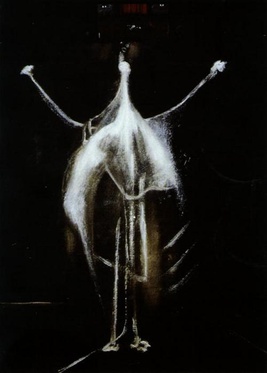
Crucifixion is an early oil on canvas painting by Francis Bacon, made in 1933 when Bacon was aged 23 or 24. It was one of three paintings on the subject of the Crucifixion that he made in 1933, the others being his Crucifixion with Skull, commissioned by art collector Sir Michael Sadler, and Wound for a Crucifixion. It is held in Damien Hirst's Murderme Collection.










